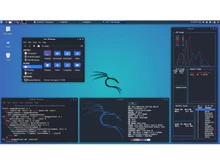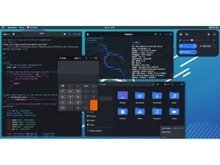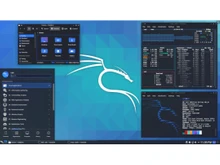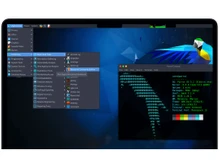Kali Linux vs Parrot OS: Which Cybersecurity OS Should You Choose?
With the ongoing threat of cyberattacks, two Linux-based distributions are getting popular in the ethical hacking landscape. Both Parrot OS and Kali Linux are secure operating systems tailored for penetration testing, digital forensics, and cybersecurity operations.
However, they cater to different types of users and usage scenarios. If you're wondering whether to use Parrot OS or Kali Linux, this guide will help you make an informed decision based on their features, performance, use cases, and user experience.
Key Differences Between Kali Linux vs Parrot OS
- Usability: Kali is designed for professionals who use Linux commands and manual tool configurations. Parrot OS, on the other hand, offers a more user-friendly interface. One of the biggest limitations of Kali Linux over Parrot OS is its steep learning curve.
- Budget-friendly: Both Kali Linux and Parrot OS are free and open-source operating systems. However, Parrot OS requires lower hardware. It also works on basic systems, making it more accessible to students who don’t want to invest in high-spec machines.
- Privacy: Parrot OS is more versatile for cloud-based operations and secure browsing, especially when using tools like AnonSurf and Tor for anonymity. Whereas Kali Linux is a standalone testing OS and isn’t optimized for privacy-focused tasks.
- Offline: Both systems support offline use. Parrot OS is cloud-friendly and runs effectively offline with lightweight efficiency. But Kali Linux is typically deployed in offline penetration test environments due to its better toolsets.
- Workflows: Parrot OS allows a more customizable desktop environment (with options like MATE) and supports multiple workflows. While Kali Linux is highly configurable, its structure is more rigid and focused on penetration testing workflows alone.
Comparison Table: Parrot OS vs Kali Linux
Both Parrot OS and Kali Linux are widely used for cybersecurity, ethical hacking, and penetration testing. However, they differ significantly in design philosophy, user experience, and target audience. Below are the core distinctions between these two operating systems:
| Comparison of Parrot OS and Kali Linux |
| Feature | Parrot OS | Kali Linux |
| Primary Use | Security, Privacy, Development | Penetration Testing, Red Teaming |
| Focus | Penetration Testing, Ethical Hacking, Privacy, Encryption | Penetration Testing, Ethical Hacking, Digital Forensics |
| User Interface | Lightweight MATE or KDE | GNOME or XFCE (heavier) |
| Ease of Use | Beginner-friendly and polished UI | Professional-grade and steeper learning curve |
| Anonymity Tools | Anonsurf, Tor, I2P included | Minimal anonymity support |
| Toolset | 600+ tools, balanced for multi-use | 600+ tools focused on offensive security |
| System Requirements | Lightweight and low RAM usage | Higher resource consumption |
| Offline Use | Fully functional offline | Fully functional offline |
| Cloud & VM Use | Great for cloud/VMs, lightweight | Heavier but widely supported in cloud labs |
| Customization | Highly customizable and supports multiple workflows | Moderate customization available and high focused on pentesting |
| Training/Certifications | Community-driven | Official certifications (OSCP, PWK) |
| Stability | Faster updates and sometimes less stable | Enterprise-grade stability |
| Installation Size | 16 GB | 20 GB |
Detailed Feature Comparison of Kali Linux vs Parrot OS
Choosing between Parrot OS and Kali Linux isn’t always straightforward. While both serve cybersecurity professionals and ethical hackers, their tools, performance, and user experience differ significantly. Below is a breakdown based on critical criteria, helping both beginners and current users evaluate whether to switch or stick with their current OS.
User Interface and User Experience (UI/UX)
Parrot OS offers a lightweight and polished MATE desktop environment. It is designed to run smoothly even on lower-end machines. This operating system mimics the feel of traditional Linux desktops and provides a seamless user experience for both beginners and developers. Whereas Kali Linux comes with GNOME (default) or XFCE, which can feel a bit heavy and less responsive on older hardware. While it’s customizable, its interface prioritizes functionality over aesthetics or ease.
Verdict: Parrot OS wins for smoother and more accessible UI, especially for daily use or multitasking.
Toolset and Capabilities
Kali Linux is focused on advanced penetration testing, red teaming, and security auditing. It includes 600+ pre-installed tools ranging from Metasploit and Burp Suite to Aircrack-ng and Wireshark. On the other hand, Parrot OS offers a comparable toolset, but with additional emphasis on development tools, secure browsing, cryptography, and privacy-enhancing utilities like Anonsurf and Tor.
Verdict: Kali is better for professionals performing deep pentesting. Parrot is ideal for a broader mix of privacy, dev, and security tasks.
Performance and Resource Usage
Parrot OS is significantly lighter, optimized to run on systems with limited resources (even 2GB RAM), making it ideal for virtual machines or old laptops. In contrast, Kali Linux consumes more memory and disk space, and may lag on lightweight systems.
Verdict: Parrot OS is better for users with limited resources or those running multiple VMs.
Anonymity and Privacy
Parrot OS is designed with privacy-first principles, integrating AnonSurf, Tor, I2P, and other anonymity networks right out of the box. Kali Linux is focused on exploit research and offensive security. It consists of minimal privacy tools unless installed manually.
Verdict: Parrot OS clearly leads for users prioritizing anonymity and secure communication.
Community Support and Learning Resources
Kali Linux has a massive, long-established community, robust documentation, and official training from Offensive Security (OSCP, PWK). Parrot OS has a smaller but growing community, with increasing forums, tutorials, and YouTube content, but lacks formal certification programs.
Verdict: Kali wins for professional training and documentation; Parrot suits self-learners and privacy advocates.
System Requirements and Compatibility
| Comparison of Parrot OS and Kali Linux (System Requirements) |
| Feature | Parrot OS | Kali Linux |
| RAM | 2 GB (Minimum) | 4 GB Recommended |
| CPU | 1 GHz Dual Core | 1 GHz or faster |
| Disk Space | 16 GB | 20 GB |
| Desktop Options | MATE, KDE | GNOME, XFCE |
| Architecture | x86, x64, ARM | x86, x64, ARM, ARM64 |
| Supported Devices | PCs, VMs, Raspberry Pi | PCs, VMs, Mobile, Raspberry Pi |
Update Frequency and Stability
Kali Linux maintains a stable release cycle, ideal for enterprise and field usage. Updates are tested and vetted by Offensive Security. On the other hand, Parrot OS releases updates more frequently, but this can introduce occasional bugs or instability.
Verdict: Kali is better for production use, whereas Parrot offers faster feature rollouts for testers and developers.
Customization and Workflow Flexibility
Parrot OS allows greater desktop and workflow customization, supporting multiple use cases: coding, secure browsing, and system hardening. Whereas Kali Linux is focused on penetration testing, and while it can be customized, it’s not optimized for non-security workflows.
Verdict: Parrot OS is more flexible for multipurpose use.
Virtualization and Cloud Use
Parrot OS is better suited for lightweight virtual machines and cloud usage, thanks to lower overhead and built-in anonymity tools. In contrast, Kali Linux is heavier but widely used in cloud labs, virtual penetration test setups, and enterprise simulations.
Verdict: Use Parrot for personal VM setups and privacy work; Kali for professional cloud penetration testing.
SWOT Analysis: Parrot OS vs Kali Linux
| SWOT Analysis of Parrot OS and Kali Linux |
| Aspect | Parrot OS | Kali Linux |
| Strengths | Lightweight, privacy tools, beginner-friendly | Industry standard, full toolkit, strong community |
| Weaknesses | Less stable, fewer formal resources | Resource-heavy, steep learning curve |
| Opportunities | Ideal for privacy-first users and secure dev | Ideal for red teaming and enterprise audits |
| Threats | May not support all tools out-of-the-box | Overkill for beginners or casual users |
Security and Privacy: Who Wins?
- Parrot OS is better in terms of privacy and anonymity, featuring tools that allow for encrypted communications, anonymous browsing, and secure data management.
- Kali Linux prioritizes offensive security, with fewer out-of-the-box features for privacy but more robust tools for vulnerability exploitation and forensic investigation.
When to choose Kali Linux or Parrot OS?
| Use Cases and Best Operating System |
| Use Case | Best Operating System |
| Learning Ethical Hacking | Parrot OS |
| OSCP or Professional Certifications | Kali Linux |
| Lightweight VM or Raspberry Pi Install | Parrot OS |
| Corporate Red Team Testing | Kali Linux |
| Daily Use with Secure Web Access | Parrot OS |
| On-site Penetration Testing | Kali Linux |
Final Verdict: Which OS is best, Kali Linux vs Parrot OS?
Both Parrot OS and Kali Linux are excellent operating systems for cybersecurity tasks, but your choice should depend on your experience level, use case, and hardware resources.
Choose Parrot OS if you need a lightweight, multipurpose security OS, you are new to ethical hacking or cybersecurity, want privacy-focused tools and better UI/UX, and need to run on older hardware or VMs.
Choose Kali Linux if you are preparing for OSCP or other certifications, work in enterprise or government-level pentesting, want the most robust, professional-grade toolkit, and need access to a mature support ecosystem.
In the battle of Parrot OS vs Kali Linux, there’s no absolute winner!
Only the right tool for your specific use case will win. If you want a lightweight, privacy-focused OS that doubles as a secure daily driver, go for Parrot OS. If you need a comprehensive, professional penetration testing platform, then Kali Linux is your best bet.
Tip: Try both in a virtual machine environment before installing them on bare metal to see which suits your workflow best. If you need better operating system or security tool advice, contact our software advisors.


 6 Ratings & 0 Reviews
6 Ratings & 0 Reviews

















